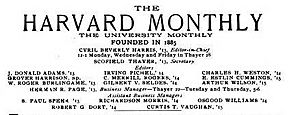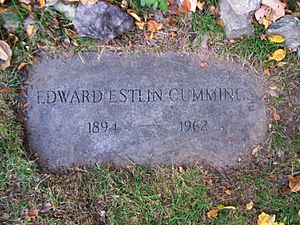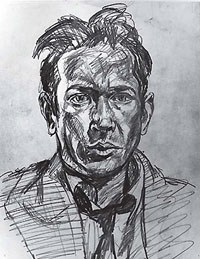E. E. Cummings facts for kids
Quick facts for kids
E. E. Cummings
|
|
|---|---|

Cummings in 1953
|
|
| Born |
Edward Estlin Cummings
October 14, 1894 Cambridge, Massachusetts, U.S.
|
| Died | September 3, 1962 (aged 67) Madison, New Hampshire, U.S.
|
| Alma mater | Harvard University |
| Occupation | Author |
| Signature | |
Edward Estlin Cummings, who was also known as E. E. Cummings, e. e. cummings and e e cummings (October 14, 1894 - September 3, 1962), was an American poet, painter, essayist, author and playwright. He wrote approximately 2,900 poems, two autobiographical novels, four plays, and several essays. He is often regarded as one of the most important American poets of the 20th century. Cummings is associated with modernist free-form poetry. Much of his work has idiosyncratic syntax and uses lower-case spellings for poetic expression.
Contents
Life
Early years
Edward Estlin Cummings was born on October 14, 1894, in Cambridge, Massachusetts, to Edward Cummings and the former Rebecca Haswell Clarke, a well-known Unitarian couple in the city. His father was a professor at Harvard University who later became nationally known as the minister of South Congregational Church (Unitarian) in Boston, Massachusetts. His mother, who loved to spend time with her children, played games with Cummings and his sister, Elizabeth. From an early age, Cummings' parents supported his creative gifts. Cummings wrote poems and drew as a child, and he often played outdoors with the many other children who lived in his neighborhood. He grew up in the company of such family friends as the philosophers William James and Josiah Royce. Many of Cummings' summers were spent on Silver Lake in Madison, New Hampshire, where his father had built two houses along the eastern shore. The family ultimately purchased the nearby Joy Farm where Cummings had his primary summer residence.
He expressed transcendental leanings his entire life. As he matured, Cummings moved to an "I, Thou" relationship with God. His journals are replete with references to "le bon Dieu", as well as prayers for inspiration in his poetry and artwork (such as "Bon Dieu! may i some day do something truly great. amen."). Cummings "also prayed for strength to be his essential self ('may I be I is the only prayer—not may I be great or good or beautiful or wise or strong'), and for relief of spirit in times of depression ('almighty God! I thank thee for my soul; & may I never die spiritually into a mere mind through disease of loneliness')".
Cummings wanted to be a poet from childhood and wrote poetry daily from age 8 to 22, exploring assorted forms. He graduated from Harvard University with a Bachelor of Arts degree magna cum laude and Phi Beta Kappa in 1915 and received a Master of Arts degree from the university in 1916. In his studies at Harvard, he developed an interest in modern poetry, which ignored conventional grammar and syntax, while aiming for a dynamic use of language. Upon graduating, he worked for a book dealer.
War years
In 1917, with the First World War ongoing in Europe, Cummings enlisted in the Norton-Harjes Ambulance Corps. On the boat to France, he met William Slater Brown and they would become friends. Due to an administrative error, Cummings and Brown did not receive an assignment for five weeks, a period they spent exploring Paris. Cummings fell in love with the city, to which he would return throughout his life.
During their service in the ambulance corps, the two young writers sent letters home that drew the attention of the military censors. They were known to prefer the company of French soldiers over fellow ambulance drivers. The two openly expressed anti-war views; Cummings spoke of his lack of hatred for the Germans. On September 21, 1917, five months after starting his belated assignment, Cummings and William Slater Brown were arrested by the French military on suspicion of espionage and undesirable activities. They were held for three and a half months in a military detention camp at the Dépôt de Triage, in La Ferté-Macé, Orne, Normandy.
They were imprisoned with other detainees in a large room. Cummings' father failed to obtain his son's release through diplomatic channels, and in December 1917 he wrote a letter to President Woodrow Wilson. Cummings was released on December 19, 1917, and Brown was released two months later. Cummings used his prison experience as the basis for his novel, The Enormous Room (1922), about which F. Scott Fitzgerald said, "Of all the work by young men who have sprung up since 1920 one book survives—The Enormous Room by e.e. cummings ... Those few who cause books to live have not been able to endure the thought of its mortality."
Cummings returned to the United States on New Year's Day 1918. Later in 1918 he was drafted into the army. He served a training deployment in the 12th Division at Camp Devens, Massachusetts, until November 1918.
Post-war years
Cummings returned to Paris in 1921 and lived there for two years before returning to New York. His collection Tulips and Chimneys was published in 1923 and his inventive use of grammar and syntax is evident. The book was heavily cut by his editor. XLI Poems was published in 1925. With these collections, Cummings made his reputation as an avant garde poet.
During the rest of the 1920s and 1930s, Cummings returned to Paris a number of times, and traveled throughout Europe, meeting, among others, artist Pablo Picasso. In 1931 Cummings traveled to the Soviet Union, recounting his experiences in Eimi, published two years later. During these years Cummings also traveled to Northern Africa and Mexico. He worked as an essayist and portrait artist for Vanity Fair magazine (1924–1927).
In 1926, Cummings' parents were in a car crash; only his mother survived, although she was severely injured.
His father's death had a profound effect on Cummings, who entered a new period in his artistic life. He began to focus on more important aspects of life in his poetry. He started this new period by paying homage to his father in the poem "my father moved through dooms of love".
In the 1930s Samuel Aiwaz Jacobs was Cummings' publisher; he had started the Golden Eagle Press after working as a typographer and publisher.
Final years
In 1952, his alma mater, Harvard University, awarded Cummings an honorary seat as a guest professor. The Charles Eliot Norton Lectures he gave in 1952 and 1955 were later collected as i: six nonlectures.
Cummings spent the last decade of his life traveling, fulfilling speaking engagements, and spending time at his summer home, Joy Farm, in Silver Lake, New Hampshire. He died of a stroke on September 3, 1962, at the age of 67 at Memorial Hospital in North Conway, New Hampshire. Cummings was buried at Forest Hills Cemetery in Boston, Massachusetts. At the time of his death, Cummings was recognized as the "second most widely read poet in the United States, after Robert Frost".
Cummings' papers are held at the Houghton Library at Harvard University and the Harry Ransom Center at the University of Texas at Austin.
Personal life
Marriages
Cummings was married briefly twice, first to Elaine Thayer, then to Anne Minnerly Barton. His longest relationship lasted more than three decades with Marion Morehouse.
Cummings' first marriage, to Elaine Orr, his cousin, began as a love affair in 1918 while she was still married to Scofield Thayer, one of Cummings' friends from Harvard. The couple had a daughter together. After divorcing Thayer, Orr married Cummings on March 19, 1924. However, the couple separated after two months of marriage and divorced less than nine months later.
Cummings married his second wife Anne Minnerly Barton on May 1, 1929. They separated three years later in 1932. That same year, Minnerly obtained a Mexican divorce; it was not officially recognized in the United States until August 1934.
In 1934, after his separation from his second wife, Cummings met Marion Morehouse, a fashion model and photographer. Although it is not clear whether the two were ever formally married, Morehouse lived with Cummings until his death in 1962.
Political views
According to his testimony in EIMI, Cummings had little interest in politics until his trip to the Soviet Union in 1931. He subsequently shifted rightward on many political and social issues. Despite his radical and bohemian public image, he was a Republican and later an ardent supporter of Joseph McCarthy.
Work
Poetry
Despite Cummings' familiarity with avant-garde styles, much of his work is quite traditional. Many of his poems are sonnets. He occasionally used the blues form and acrostics. Cummings' poetry often deals with themes of love and nature, as well as the relationship of the individual to the masses and to the world. His poems are also often rife with satire.
As well as being influenced by notable modernists, including Gertrude Stein and Ezra Pound, Cummings in his early work drew upon the imagist experiments of Amy Lowell. Later, his visits to Paris exposed him to Dada and Surrealism. He began to rely on symbolism and allegory, where he once had used simile and metaphor. Cummings also liked to incorporate imagery of nature and death into much of his poetry.
While some of his poetry is free verse (with no concern for rhyme or meter), many have a recognizable sonnet structure of 14 lines, with an intricate rhyme scheme. A number of his poems feature a typographically exuberant style, with words, parts of words, or punctuation symbols scattered across the page, often making little sense until read aloud, at which point the meaning and emotion become clear. Cummings, who was also a painter, understood the importance of presentation, and used typography to "paint a picture" with some of his poems.
The seeds of Cummings' unconventional style appear well established even in his earliest work. At age six, he wrote to his father:
FATHER DEAR. BE, YOUR FATHER-GOOD AND GOOD,
HE IS GOOD NOW, IT IS NOT GOOD TO SEE IT RAIN,
FATHER DEAR IS, IT, DEAR, NO FATHER DEAR,
LOVE, YOU DEAR,
ESTLIN.
Following his autobiographical novel, The Enormous Room, Cummings' first published work was a collection of poems titled Tulips and Chimneys (1923). This work was the public's first encounter with his characteristically eccentric use of grammar and punctuation.
Some of Cummings' most famous poems do not involve much, if any, idiosyncratic typography or punctuation, but they still carry his unmistakable style, particularly in unusual and impressionistic word order.
Many of Cummings' poems are satirical and address social issues.
Cummings also wrote children's books and novels. A notable example of his versatility is an introduction he wrote for a collection of the comic strip Krazy Kat.
Plays
During his lifetime, Cummings published four plays, including HIM (1927) and Santa Claus: A Morality (1946).
Art
Cummings was an avid visual artist, referring to writing and painting as his twin obsessions
and to himself as a poetandpainter.
He painted continuously, relentlessly, from childhood until his death, and left in his estate more than 1600 oils and watercolors (a figure that does not include the works he sold during his career) and over 9,000 drawings.
In a self-interview from Foreword to an Exhibit: II (1945), the artist asked himself, Tell me, doesn’t your painting interfere with your writing?
and answered, Quite the contrary: they love each other dearly.
Cummings had more than 30 exhibits of his paintings in his lifetime. He received substantial acclaim as an American cubist and an abstract, avant garde painter between the World Wars, but with the publication of his books The Enormous Room and Tulips and Chimneys in the 1920s, his reputation as a poet eclipsed his success as a visual artist. In 1931, he published a limited edition volume of his artwork entitled CIOPW, named for his media of charcoal, ink, oil, pencil, and watercolor. About this same time, he began to break from Modernist aesthetics and employ a more subjective and spontaneous style.
Name and capitalization
Cummings' publishers and others have often echoed the unconventional orthography in his poetry by writing his name in lower case. Cummings himself used both the lowercase and capitalized versions, though he most often signed his name with capitals.
The use of lower case for his initials was popularized in part by the title of some books, particularly in the 1960s, printing his name in lower case on the cover and spine. In the preface to E. E. Cummings: The Growth of a Writer by Norman Friedman, critic Harry T. Moore notes Cummings "had his name put legally into lower case, and in his later books the titles and his name were always in lower case". According to Cummings' widow, however, this is incorrect. She wrote to Friedman: "You should not have allowed H. Moore to make such a stupid & childish statement about Cummings & his signature." On February 27, 1951, Cummings wrote to his French translator D. Jon Grossman that he preferred the use of upper case for the particular edition they were working on. One Cummings scholar believes that on the rare occasions that Cummings signed his name in all lower case, he may have intended it as a gesture of humility, not as an indication that it was the preferred orthography for others to use. Additionally, The Chicago Manual of Style, which prescribes favoring non-standard capitalization of names in accordance with the bearer's strongly stated preference, notes "E. E. Cummings can be safely capitalized; it was one of his publishers, not he himself, who lowercased his name."
Adaptations
In 1943, modern dancer and choreographer Jean Erdman presented "The Transformations of Medusa, Forever and Sunsmell" with a commissioned score by John Cage and a spoken text from the title poem by E. E. Cummings, sponsored by the Arts Club of Chicago. Erdman also choreographed "Twenty Poems" (1960), a cycle of E. E. Cummings' poems for eight dancers and one actor, with a commissioned score by Teiji Ito. It was performed in the round at the Circle in the Square Theatre in Greenwich Village.
Numerous composers have set Cummings' poems to music:
- In 1961, Pierre Boulez composed cummings ist der dichter from poems by E. E. Cummings.
- Aribert Reimann set Cummings to music in "Impression IV" (1961) for soprano and piano.
- Morton Feldman (1926–1987) in 1951 composed "4 Songs to e.e. cummings" for soprano, piano and cello, using material from Cummings' "50 poems" of 1940: "!Blac", "Air", "(Sitting In A Tree-)" and "(Moan)".
- The Icelandic singer Björk used lines from Cummings' poem "I Will Wade Out" for the lyrics of "Sun in My Mouth" on her 2001 album Vespertine. On her next album, Medúlla (2004), Björk used his poem "It May Not Always Be So" as the lyrics for the song "Sonnets/Unrealities XI".
- The American composer Eric Whitacre wrote a cycle of works for choir titled The City and the Sea, which consists of five poems by Cummings set to music. He also wrote music for “little tree” and “i carry your heart,” among others.
- Others who have composed settings for his poems include Dominic Argento, William Bergsma, Leonard Bernstein, Marc Blitzstein, John Cage, Romeo Cascarino, Aaron Copland, Serge de Gastyne, David Diamond, John Duke, Margaret Garwood, Daron Hagen, Michael Hedges, Timothy Hoekman, Richard Hundley, Barbara Kolb, Leonard Lehrman, Robert Manno, Salvatore Martirano, William Mayer, John Musto, Paul Nordoff, Tobias Picker, Vincent Persichetti, Ned Rorem, Peter Schickele, Elie Siegmeister, Ann Loomis Silsbee, Aki Takase, Hugo Weisgall, Dan Welcher, and James Yannatos, among many others.
Awards
During his lifetime, Cummings received numerous awards in recognition of his work, including:
- Dial Award (1925)
- Guggenheim Fellowship (1933)
- Shelley Memorial Award for Poetry (1945)
- Harriet Monroe Prize from Poetry magazine (1950)
- Fellowship of American Academy of Poets (1950)
- Guggenheim Fellowship (1951)
- Charles Eliot Norton Professorship at Harvard (1952–1953)
- Special citation from the National Book Award Committee for his Poems, 1923–1954 (1957)
- Bollingen Prize in Poetry (1958)
- Boston Arts Festival Award (1957)
- Two-year Ford Foundation grant of $15,000 (1959)
See also
 In Spanish: E. E. Cummings para niños
In Spanish: E. E. Cummings para niños




